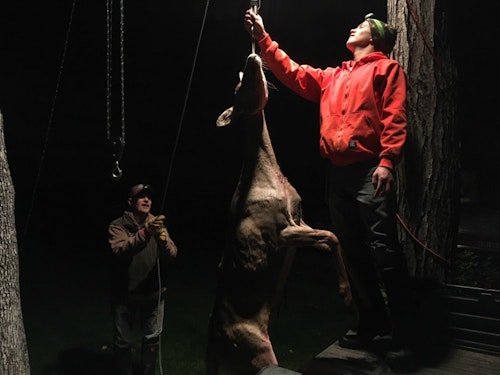If you’re a fan of fixed-blade broadheads — like me — perhaps you’ve wondered: Why do some bowhunters prefer models with serrated blades? Before I dive into answering that question, let me back up just a bit.
Even though I’ve killed big game with fixed-blade broadheads for decades, I hesitate to call myself an expert on the subject. That said, I do have opinions based on firsthand experience, and I’ve done a fair amount of research about different fixed-blade broadhead designs.
During the past 7 years, I’ve used only fixed-blade broadheads for big game, and the two models found in my quivers (for compounds and crossbows) both feature serrated blades. Specifically I’ve been using 125-grain, four-blade Magnus Stinger Buzzcuts, and 125-grain, four-blade Magnus Black Hornet Ser Razor broadheads. Another proven choice featuring serrated blades is the Steel Force Sabertooth.

The Theory Behind Serrated Blades
As a broadhead passes through the chest of a whitetail or other big game animal, it impacts some or all of the following: hide, muscle, bones and soft tissue (internal organs, arteries, etc.). Of course, a scary-sharp broadhead will cut the most tissue as it passes through an animal, so it’s important for any bowhunter to carry sharp heads into the field. With archery, big game animals die due to loss of blood, so it’s critical for a broadhead to do the most tissue damage possible.
So, why do some experienced bowhunters think that serrated blades do the best job in this regard?
Let’s assume you’re shooting a fixed-blade head that doesn’t have serrated blades. You take a 15-yard shot at a broadside buck, hitting him perfectly in the chest. The big unknown, even for a well-placed shot, is whether that broadhead will impact ribs as it passes through the buck’s chest. Of course, if the broadhead centerpunches a rib, it might not penetrate fully, especially if the hunter shoots a low-poundage bow or has a short draw length (or both), but that’s a topic for another time.
Let’s say the broadhead strikes the edge of a rib before entering the chest cavity. When the blade hits the rib, it begins to dull — immediately. It would be no different than you taking a fresh broadhead and running one edge of it on something hard like a rock. The blade would quickly become dull, or at least far less sharp than before.
As this broadhead continues into the chest cavity, it will impact the animal’s lungs and other soft tissue, and while it will cut to some degree, it won’t do the same amount of damage as it would had it not impacted bone first. As the broadhead leaves the chest cavity, it might impact a rib again, then it must cut hide to exit the animal. Of course, a dull broadhead will have more trouble with this task than it would if it were sharp.
At this point of my article I probably haven’t described anything that’s surprising or new to you. So, what’s different in this scenario if a broadhead with serrated blades is used?
As a serrated blade strikes the edge of a rib upon entering the buck, it also becomes dull, just like the non-serrated blade. However — and this is the key — with a serrated blade, only the outer edge of the blade touches bone; the small valleys or recesses in the serration section do not. The recesses stay wicked sharp, which means as the broadhead enters the chest cavity, the recesses continue to cut soft tissue (lungs, etc.) extremely well, causing the maximum amount of damage and blood loss.
The way I see it, because it’s impossible to know whether my fixed-blade broadhead will strike rib bone as it enters (and hopefully exits) an animal, it’s smart to use a serrated blade just in case. I can avoid shoulder bone with good shot placement, but whether my broadhead hits rib bone is anyone’s guess. FYI: Yes, it’s possible to sharpen the recesses of a serrated blade. Click here to watch a detailed video on the subject.








